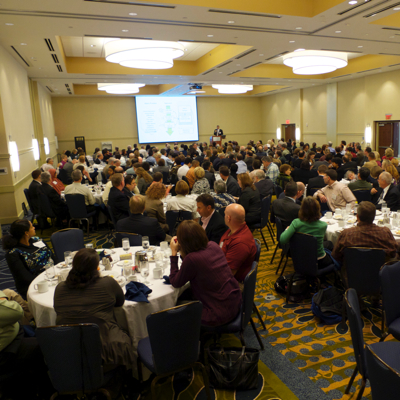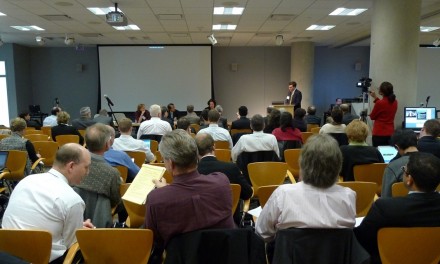What makes the annual HIMSS meeting special? Many vendors release new products or make important announcements at HIMSS. Of the huge number of exhibitors, vendors bring more than sales reps to attend HIMSS. This is a great opportunity to have meaningful conversations with product managers, engineers and a variety of company executives to discuss detailed product and implementation questions, product roadmaps and connectivity with other vendor's systems.
Perhaps the biggest advantage of HIMSS is that you can do this across numerous vendors, looking at both competitors and potential vendor collaborators in a broader overall solution. The only practical alternative to doing this at HIMSS is to visit vendors at their corporate locations, a much more expensive and time consuming endeavor.
How to Maximize Your HIMSS Experience
If you're a provider, you need a list of vendors, your key questions and the role or title of the person(s) with whom you want to discuss those questions. Craft your questions and then schedule meetings with each vendor, and the appropriate vendor contact, prior to HIMSS (now would be a good time to do this). During your meetings make sure the hard questions are all asked, and that clear and concise answers are received from the vendor. Take notes. After, HIMSS consolidate the notes and what you learned in a brief report to share with the team. In this scenario the keys to success are asking the right questions and getting a meeting with the right person(s) to get the most meaningful answers to those questions.
At my last HIMSS, I worked with a hospital system evaluating surveillance monitoring systems. I've also done similar efforts around real-time location systems (RTLS), medical device connectivity solutions, cardiology information systems and other types of point-of-care solutions.
If you're a vendor, you too need a list of vendors. These are likely competitors, but could also be potential collaborators in broader based solutions. Identify the role or title of the people who will have the information you're seeking — LinkedIn can be most helpful here. HIMSS is a great business development environment, and setting up face-to-face meetings with other vendors is a common occurrence.
Gathering competitive information is a bigger challenge. Gathering public information from competitors is a challenge when you are one of their competitors. That big EXHIBITOR badge will get you ejected from competitor's booths, and I've even seen vendor reps stand in front of competitors standing in the aisles in an attempt to block their view. Back in my product manager days, sales reps working trade shows were regularly assigned to gather competitive information. The result was rarely fulfilling. Trusted customers attending a trade show are sometimes pressed into competitive intelligence work. Certainly competitors will be free with their information with an end user, but customers tend to lack the perspective and discipline to ask the right questions and get all the details that are important.
The best source for competitive intelligence at HIMSS is a third party who can schedule and have meetings with target companies. While the information gathered will still be public and not confidential or proprietary, the most comprehensive package of public competitive information can be gathered on each company. I have done many bus dev (including investor research) and competitive assignments at HIMSS. In my experience the best results come from selecting a few key competitors (6 or less) and getting a deep amount of information, rather than trying to gather information on a larger number of competitors. Like with providers, asking the right questions and getting answers from the right people — including customers and prospects that you can meet in the competitor's booth — is the key to success.
My Goals
My goals this year are to meet with and learn more about the mHealth vendors I follow, especially those in the broader secure messaging and orchestration markets. I also hope to swing by some surveillance monitoring, nurse call and RTLS booths.
Once again I'm sharing my spreadsheet of exhibitors with readers. You can use this list of over 50 exhibitors and their booth numbers to identify interesting digital health exhibitors and organize your march across the exhibit floors. If you're interested, you can download the spreadsheet here.
I also still have time on my schedule to entertain information gathering projects for providers and/or vendors. Grab some time on my calendar so we can discuss your objectives.
What's Hot and What's Not
Like any big social event, there's always a lot of discussion on the "big trends" for a given year of HIMSS. There are many ways to look at this (market demand, what vendors are promoting, regulatory initiatives, etc.). And afterwards, a myriad of opinion pieces purport to detail "what it all means." This is all good fodder for social interactions and mildly entertaining, but of limited practical use.
For practical value, such questions need to be based on data. And the best data I've seen on this comes from Drew Ivan. For the past few years, Drew has analyzed the educational sessions at HIMSS as an indicator of trends or relative market interest. Drew has done another analysis of the educational sessions on the program for HIMSS18. The analysis this year looks at trends going back to 2015. Go check it out.
What Else to Do
Las Vegas is my least favorite HIMSS location. The crush of HIMSS itself is bad enough. Step outside the conference center and there's mobs on the sidewalks and in all the other hotel/casinos (well, the nice ones, anyway). In 2016 we came early and spent a day at Red Rock Canyon and Valley of Fire parks, just outside of Las Vegas. The image above is from Valley of Fire. You'll need a rental car, sneakers, water and a lunch, but it's a great way to spend a half or full day and prepare for the HIMSS crush.
If you see me at HIMSS18, be sure to stop and say hello. I'd love to see you.




Recent Comments